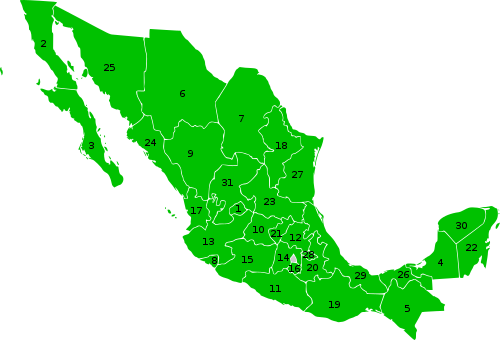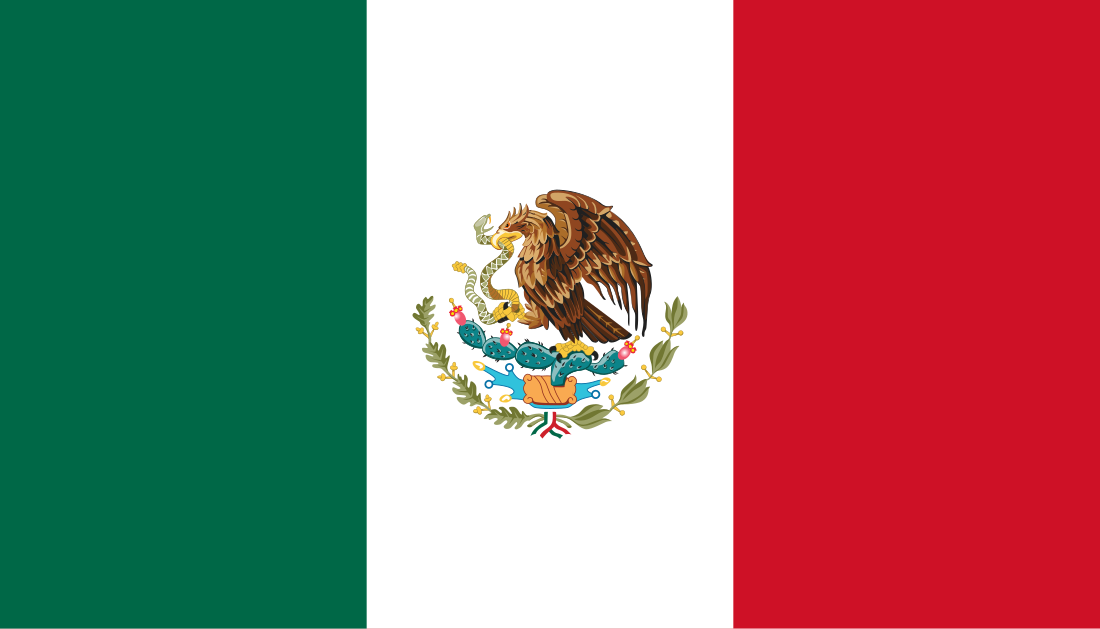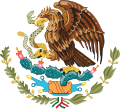Mexico
country in North America From Wikipedia, the free encyclopedia
Mexico (Spanish: México; official name: United Mexican States Spanish: Estados Unidos Mexicanos, ![]() listen (help·info)[11]) is a country in North America. It is located in the south of Texas, California and other American states. Guatemala and Belize are in the south of Mexico. It is located between the Pacific Ocean and the Gulf of Mexico.
listen (help·info)[11]) is a country in North America. It is located in the south of Texas, California and other American states. Guatemala and Belize are in the south of Mexico. It is located between the Pacific Ocean and the Gulf of Mexico.
United Mexican States | |
|---|---|
| Anthem: "Himno Nacional Mexicano" Mexican National Anthem | |
| National seal: Seal of the United Mexican States | |
 | |
| Capital and largest city | Mexico City 19°26′N 99°08′W |
| Official languages | None at federal level[a] |
| National language | Mexican Spanish[a] |
| Recognized regional languages | 68 indigenous languages |
| Ethnic groups | - Mestizo 60%[2] - Indigenous 28%[2] - European 9%[3] - African 1%[4] - Other 1%[2] |
| Demonym(s) | Mexican |
| Government | Federal presidential constitutional republic[5] |
| Claudia Sheinbaum (MORENA) | |
| Gerardo Fernández Noroña | |
| Ifigenia Martínez y Hernández | |
| Legislature | Congress |
| Senate | |
| Chamber of Deputies | |
| Independence from Spain | |
• Declared | September 16, 1810 |
• Recognized | September 27, 1821 |
| Area | |
• Total | 1,972,550 km2 (761,610 sq mi) (14th) |
• Water (%) | 2.5 |
| Population | |
• 2010 census | 112,322,758[6] (11th) |
• Density | 57/km2 (147.6/sq mi) (142nd) |
| GDP (PPP) | 2011 estimate |
• Total | $1.629 trillion[7] (11th) |
• Per capita | $21.430[8] (58th) |
| GDP (nominal) | 2011 estimate |
• Total | $1.041 trillion[7] (13th) |
• Per capita | $9,489[7] (58th) |
| Gini (2008) | 51.6[9] high |
| HDI (2011) | 0.770[10] high · 57th |
| Currency | Peso (MXN) |
| Time zone | UTC−8 to −6 (Official Mexican Timezones) |
| UTC−7 to −5 (varies) | |
| Driving side | right |
| Calling code | +52 |
| ISO 3166 code | MX |
| Internet TLD | .mx |
People living in Mexico or who are from there are called Mexicans. Most people speak Spanish as their native language. Some Mexicans speak Native American languages, like Nahuatl, Mayan, and Zapotec. Most modern people are descended from Native Americans such as Aztecs and Mayans and mostly have native blood. They are Catholic. The capital of Mexico is Mexico City.
History
Before the Europeans came, many Native American cultures existed in Mexico. The earliest was the Olmec culture in the south. The Olmecs are famous for the large stone heads they made. On the Yucatán peninsula lived the Mayans. The Mayans lived in city states ruled by kings. The Mayans were most powerful between 200 and 900 A.D. Another powerful empire belonged to Teotihuacan. Teotihuacan was a very large city, one of the largest at that time. After Teotihuacan declined the Toltecs became powerful. Things made by the Toltecs have been found from the southern parts of the U.S. all the way to Costa Rica. A famous Toltec god is Quetzalcoatl. The Toltec culture declined too, and it was succeeded by the Aztecs. The Aztecs called their own empire Mexico. A famous Aztec king was Moctezuma II.
In 1519 the Spanish explorer Hernán Cortés came to Mexico. The Aztecs thought he was the returned Quetzalcoatl, so they did not want to fight against him. Cortes allied himself with the enemies of the Aztecs. In 1521 they conquered the Aztec capital Tenochtitlan. The Aztec Empire became part of Spain. It was called New Spain.
In 1810 the Mexican priest Miguel Hidalgo started the Mexican war of independence. In 1821 the Spanish finally retreated and Mexico became independent. The first leader of independent Mexico was Agustin de Iturbide. He set up the First Mexican Empire and became emperor. But the Mexicans were not happy with him, and in 1823 the country became a republic.
A man who was very important in Mexico in the early 19th century was Antonio López de Santa Anna. He was the president of Mexico 11 times. When he became a dictator, Texas declared independence (1836). The Battle of the Alamo was part of this Texas Revolution. Between 1846 and 1848 there was war between Mexico and the United States. In this war Mexico lost its large northern areas, which became the southwestern United States. After this war Santa Anna was sent away to Venezuela.
Between 1858 and 1861 there was war again, between liberals and conservatives. The liberal Benito Juárez won the war and became president afterwards. Juarez stayed president until France invaded Mexico and made Maximilian of Habsburg emperor of the Second Mexican Empire. But Maximilian was very unpopular. After more war he was executed in 1867, and Juarez became president again.
Conservatives thought Juarez had too much power. In 1876 they ousted him, and made Porfirio Díaz, a general who had won a battle against the French, president. Porfirio Díaz made the country wealthier, but the poor people became poorer. Franciso I. Madero started the Mexican Revolution in 1910.
The next 10 years the country was in chaos. There were many presidents who ruled for a short time and all kinds of people fought against each other. Famous people from this period are Emiliano Zapata, Pancho Villa and Francisco I. Madero. When Álvaro Obregón became president in 1920 the fighting calmed down.
In 1929 President Plutarco Elías Calles founded the National Mexican Party, PNM. The party was later renamed Institutional Revolutionary Party, PRI. The party would rule for a very long time. Most PRI presidents were not popular, it was said that they were only president to become richer themselves. An exception was president Lázaro Cárdenas. He was president between 1934 and 1940.
After several decades more and more people became unhappy with the PRI. In 1968 security forces shot at protesters, this caused several hundred deaths and became known as the Tlatelolco massacre. Another uprising was in 1994 when Zapatistas rebelled in the province Chiapas.
Mainly through election fraud, the PRI managed to stay into power until 2000, when Vicente Fox of the National Action Party, PAN, was elected president. In total the PRI had governed Mexico for 71 years.
Politics
Mexico is a constitutional federal democracy ruled by a president. The president is elected after every 6 years. The current president is Claudia Sheinbaum. Parliament has a Senate and House of Deputies.
States
 |
1. Aguascalientes |
12. Hidalgo |
23. San Luis Potosí |
Geography
Mexico is in the southern part of North America. It is roughly shaped like a triangle. Mexico is more than 3000 km (1,850 miles) long from northwest to southeast. Mexico is between two large seas: the Pacific Ocean in the West and the Gulf of Mexico and the Caribbean Sea in the East. Mexico has two large peninsulas. Baja California in the northwest, and Yucatán in the southeast. In central and western Mexico are the Sierra Madre mountains. In the Sierra Madre is the Pico de Orizaba, the highest mountain of Mexico. In central Mexico there are also a few volcanoes like the Popocatépetl and the Iztaccíhuatl. The Pico de Orizaba is also a volcano. In the north of Mexico are deserts. In the south are tropical rainforests. Some rivers in Mexico are the Río Bravo (known in the US as the Rio Grande), the Río Balsas, the Río Pánuco, and the Río Yaqui.
- Landscapes of Mexico
People
Mexico is the most populous Spanish-speaking country in the world. It is also the second most populous country in Latin America (after Brazil). 60% of Mexicans have Native American and Spanish forefathers (mostly Native American); these are called mestizos. Almost 30% of Mexicans are pure Native American and 10% are pure Spanish. Most Mexicans (90%) speak Spanish. 10% of the Mexicans speak a Native American language, like Nahuatl, the language of the Aztecs, Maya or Zapotec. Non-indigenous ethnic groups in Mexico speak another foreign language such as Arabic or Japanese. Most people in Mexico are Catholic (89%) Christians and the vast majority of Mexicans are religious and strongly believe in the Catholic Christian faith.[12]
Related pages
References
Wikiwand - on
Seamless Wikipedia browsing. On steroids.








